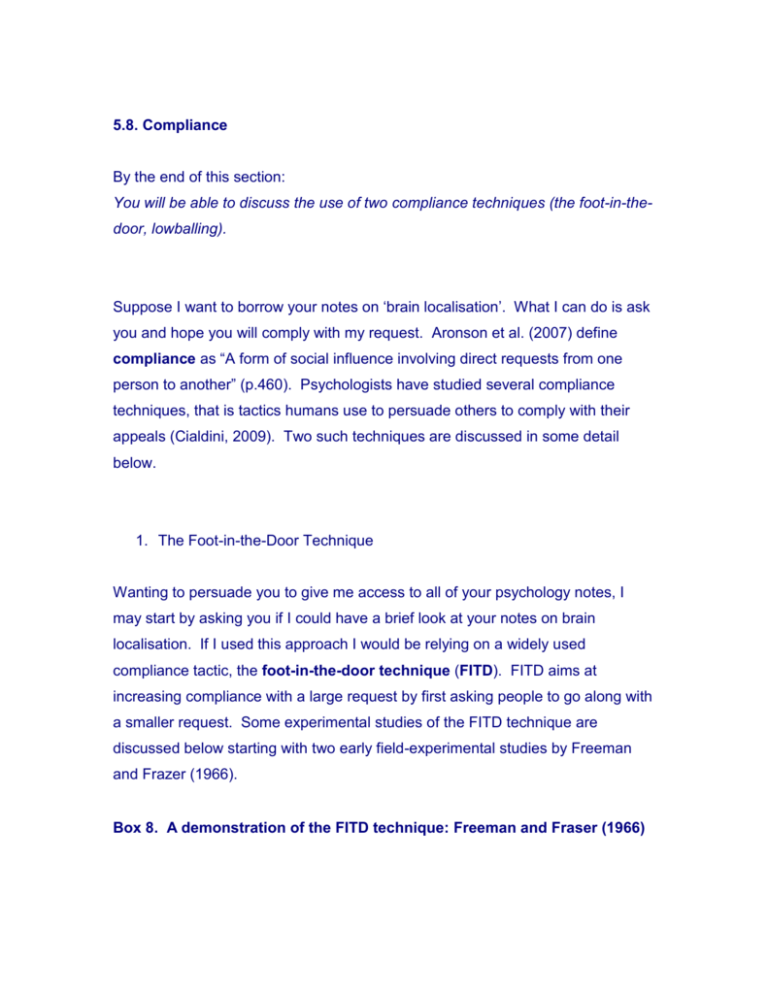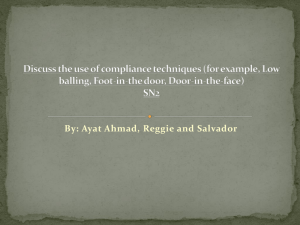compliance techniques
advertisement

5.8. Compliance By the end of this section: You will be able to discuss the use of two compliance techniques (the foot-in-thedoor, lowballing). Suppose I want to borrow your notes on ‘brain localisation’. What I can do is ask you and hope you will comply with my request. Aronson et al. (2007) define compliance as “A form of social influence involving direct requests from one person to another” (p.460). Psychologists have studied several compliance techniques, that is tactics humans use to persuade others to comply with their appeals (Cialdini, 2009). Two such techniques are discussed in some detail below. 1. The Foot-in-the-Door Technique Wanting to persuade you to give me access to all of your psychology notes, I may start by asking you if I could have a brief look at your notes on brain localisation. If I used this approach I would be relying on a widely used compliance tactic, the foot-in-the-door technique (FITD). FITD aims at increasing compliance with a large request by first asking people to go along with a smaller request. Some experimental studies of the FITD technique are discussed below starting with two early field-experimental studies by Freeman and Frazer (1966). Box 8. A demonstration of the FITD technique: Freeman and Fraser (1966) Freeman and Fraser (1966) arranged for a researcher, posing as a volunteer worker, to ask a number of householders in California to allow a big ugly publicservice sign reading ‘Drive Carefully’ to be placed on their front gardens. Only 17% of the householders complied with this request. A different set of homeowners was asked whether they would accept to display a small ‘Be a Safe Driver’ sign. Nearly all of those asked agreed with this request. Two weeks later these same homeowners were asked, by a ‘volunteer worker’, whether they would display the much bigger and ugly ‘Drive Carefully’ sign in their front gardens. 76% of them complied with this second request, a far higher percentage compared to the 17% who had complied in the first condition. In a second study Freedman and Frazer (1966) first asked a number of householders to sign a petition in favour of ‘keeping California beautiful, something nearly everybody agreed to do. After two weeks, they send a new ‘volunteer worker’ who asked these same homeowners whether they would allow the big and ugly “Drive Carefully” sign of the previous study to be displayed in their front gardens. Note that the two requests relate to completely different topics. Yet, nearly half of the homeowners agreed with the second request. This is significantly higher than the 17% of homeowners that agreed to this request in the absence of any prior contact (see above). 1. Comment on the internal validity of this filed-experimental study. 2. Is the study high on ecological validity? How could such findings be explained? The answer, according to Cialdini (2009), lies in the twin notions of consistency and commitment. Many psychologists have commented on our desire to be consistent with our beliefs, attitudes, and actions. What is crucial in the case of compliance is to secure an initial commitment as people are more willing to agree to requests that are consistent with a prior commitment (Gialdini, 2009).. But, how could the findings of the second experiment be explained? According to Freeman and Frazer (1966) the signing of ‘keeping California beautiful’ petition changed the view the homeowners had about themselves. As a result of their signing the first petition they saw themselves as unselfish citizens with welldeveloped civic principles. Agreeing, two weeks later, to display the ‘Drive Carefully’ sign simply reflected their need to comply with their newly-formed selfimage. Not only do commitments change us but also, to use Gialdini’s own expression they ‘grow their own legs’. Key fact: Be careful with commitments as the ‘grow their own legs’! Several studies have replicated and extended Freedman and Frazer’s original studies of the FITD technique. Some of the relevant findings are outlined below as they demonstrate how FITD has, or can be, be used to bring about compliance. Initial requests should not be so large that people will refuse them. (Burger, 1999). FITD requires a delay between the initial request and the later larger one (Burger, 1999). When the same person makes both requests it is difficult to get compliance (Charland et al., 1999). People with a high degree for consistency show bigger FITD effects (Cialdini et al., 1995). As Cialdini (2009) notes, the FITD technique is particularly helpful to those trying to solicit donations of time, money, effort, and even body parts. The studies discussed below testify to its extensive use by both charitable and business organisations. Sherman (1980) called residents in Indiana (USA) and asked them if, hypothetically, they would volunteer to spend 3 hours collecting for the American Cancer Society. Three days later, a second experimenter called the same people and actually requested help for this organisation. 31% of those responding to the earlier request agreed to help. This is much higher than the 4% of a similar group of people who volunteered to help when approached directly. Dolin and Booth-Butterfield (1994) found that a FITD manipulation during a health fair at a shopping mall increased compliance with a request to schedule a gynaecological examination. Using the FITD technique has also been shown to increase blood donations (Lipsitz et al, 1989) and the willingness to be an organ donor (Girandola, 2002). Meineri and Gueguen (2009) used a FITD technique to motivate people in France to take part in a demanding energy conservation project. For a randomly selected half of the participating households the request was preceded by a telephone call asking them to answer a short questionnaire on environmental issues. A higher percentage of households receiving the telephone call before the request agreed to participate in the energy-saving project. This section discussed how the FITD compliance technique in the sense that: It demonstrated the essential idea of FITD that precommitment to a small request leads to higher compliance with a subsequent, larger, request. It identified factors that can increase or decrease the effectiveness of FITD, It considered several applied settings where research indicated that FITD can be effectively used. 2. Lowballing Consider the following example. A car salesman offers a customer a good deal. After the customer accepts it, the salesperson finds an excuse to change the deal and make it less attractive to the customer. Very often customers in such situations agree to the new, and less desirable, deal. The compliance technique used in this example is called lowballing. This technique involves changing an offer to make it less attractive to the target person after this person has agreed to it. Studies of lowballing are discussed below. Box 9. A demonstration of lowballing: Burger and Cornelius (2003) In Burger and Cornelius’ study students were contacted by phone by a female caller and asked whether they would be prepared to donate five dollars to a scholarship fund for underprivileged students. There were three experimental conditions: 1. The lowball condition:, students were told that those who contributed would receive a coupon for a free smoothie at a local juice bar. Students who agreed were then informed that the investigator realised she had run out of coupons. The students were asked if they would still be willing to contribute. 77.6% agreed to make a donation in this condition. 2. The interrupt condition: the caller made the same initial request as in the lowball condition. However, before the participants had a chance to give their answer, the caller interrupted them to let them know that there were no more coupons left. Only 16% of the participants made a donation in this condition. 3. The control condition: participants were simply asked to donate the five dollars without any mention of coupons. 42% made a donation in the control condition. The results support the view that the lowball technique is based on the principle of commitment. The technique is effective only when individuals make an initial public commitment. Once they have made this initial commitment, and despite the fact that the conditions that led to it have changed, individuals feel obliged to act in accordance to the commitment (Cialdini, 2009). An impressive study by Palak et al. (1980) shows how lowballing can be used in an important real-life setting. These investigators first asked Iowa (USA) householders to conserve energy by providing them with energy-conservation tips and encouraging them to try to save fuel (natural gas). This method did not achieve any savings. Following this, a different sample of householders was contacted by the interviewer. This time, in addition to the request made of the first group, homeowners were also told that those who agreed to save energy would have their names publicised in newspaper articles describing them as good, fuel-conserving citizens. This manipulation resulted, one month later, to an average saving of 12.2% of natural gas. At this stage the homeowners received a letter informing them that it would not be possible to publicise their names in the local press after all. For the remaining winter months these families had saved 15.5%. That is more than they had saved during the time they thought they would have their names publicised in the local press. The homeowners went on saving because the commitment had ‘grown its own legs’. When the offer of publicity was withdrawn, they were able to take fuller ownership for their commitment and view themselves as fully committed to energy-saving. Cialdini (2009) claims this new self-image increased their resolve to go on saving and may explain the increased savings after receipt of the letter telling them there would be no publicity. Is lowballing more or less effective comapared to FITD? Hornik et al. (1990) compared the effectiveness of FITD and lowballing in increasing the response rate of randomly selected Israelis to telephone interviews on public health issues. Their results showed that whereas both techniques were effective, lowballing was significantly more effective in inducing compliance among the participants. Interestingly, a technique combining both the FITD and the lowballing techniques emerged as an even more effective technique compared to the other two techniques applied on their own. Exercise: List various uses of the FITD and the lowballing techniques and indicate the psychological principles on which they are based. Exercise: What ethical issues are raised by the use of compliance techniques like FITD and lowballing?






